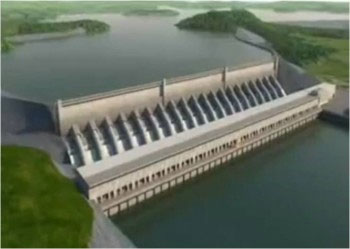Through the world's third largest hydroelectric dam construction project
The Brazilian Environment Coordinating Committee (Ibama) has just approved a project to build Belo Monte hydroelectricity, with a total investment of up to US $ 17 billion, on the Xingu River in the Amazon rainforest area. However, many experts are concerned that this project may seriously affect the environment.
 Perspective drawing of the Belo Monte hydroelectric dam.
Perspective drawing of the Belo Monte hydroelectric dam.
The above-mentioned hydroelectric power plant is located in Para state in northern Brazil, with an estimated total capacity of 11,200MW, equivalent to 11% of Brazil's electricity production. When in operation in 2015, Belo Monte will become the third largest hydropower project in the world, following China's Three Gorges Dam and Itaipu of Paraguay and Brazil.
However, this project was strongly opposed by local people and environmental protection organizations in Brazil and individual organizations around the world. Environmental experts worry that the 668-km- 2 Belo Monte dam will flood 400 km of forest, representing 0.01% of the Amazon forest area.
A group of environmentalists, including Eletrobras, Odebrecht, Camargo Corrêa, and Andrade Gutierrez, provided an assessment of the negative impact of the Belo Monte hydropower on the environment, such as changing the flora, replacing change the quality and direction of flowing water, making fish species change their migration habits.
The construction of Belo Monte hydropower will affect fish populations on the Xingu River. Scientists estimate that about 600 species of fish, of which many are only found in this river, will be overturned in the habitat, when the Belo Monte hydroelectric dam raises the stream to store water. This will threaten some species of fish in danger of extinction.
At the same time, the National Forest Research Institute of Amazon is also concerned that the construction of Belo Monte hydroelectric power might increase the greenhouse effect. According to the agency's calculations, during the first 10 years of operation, the Belo Monte dam complex will generate about 112 million tons when CO 2 and 0.783 million tons of CO 2 are generated during the construction of the Belo Monte hydroelectric dam. .
In addition, the reservoir of the Belo Monte hydroelectric plant will also generate a large amount of methane due to hundreds of square kilometers of forest being hydrated.
World Environment Day 2011
In 2011, the United Nations Environment Program (UNEP) selected the official theme for the World Environment Day (WED) 2011 as Forests: Nature At Your Service (translated as' Forest: nature in the service of friend').
Through WED, UNEP can personalize environmental issues and help people realize not only their responsibilities but also their power to promote environmental protection actions, especially in protection matters. forests because there are about 1.6 billion people in the world currently dependent on forests and forests as the Earth's natural 'air conditioner'.
World Environment Day 2011 will be held in India - the seventh largest forest area in the world. In this year's WED activities, UNEP will focus on raising awareness of the serious impact of deforestation and forest degradation. This is necessary to protect the habitat for species such as the Yellow Langur. Governments' efforts and changes in community awareness around the world will help preserve ecosystems and encourage sustainable use of forests.
- The construction site of the second largest hydropower station in the world
- The world's largest hydroelectric dam has many consequences
- Discover the world's largest hydroelectric dam
- The US supported the postponement of the construction of the Lao hydroelectric dam
- 'Conquering' the Da River to build Hoa Binh Hydroelectricity
- Will hydroelectric dams eradicate the largest Pacific salmon?
- China's largest dam is as strong as 15 nuclear reactors
- Is the Three Gorges Dam in China deformed?
- Chinese hydroelectric dams slow down the Earth
- Farmers make their own cheap mini hydroelectric plants
- Chile started construction of the world's largest telescope
- South Africa hydroelectric dam has a capacity of 480 billion liters of running water
 Vietnam 5th Asian champion on fuel-efficient vehicles
Vietnam 5th Asian champion on fuel-efficient vehicles We can read all NASA studies completely free of charge
We can read all NASA studies completely free of charge Singer and songwriter Bob Dylan won the 2016 Nobel Prize for Literature
Singer and songwriter Bob Dylan won the 2016 Nobel Prize for Literature Scientific revolution in Asia
Scientific revolution in Asia